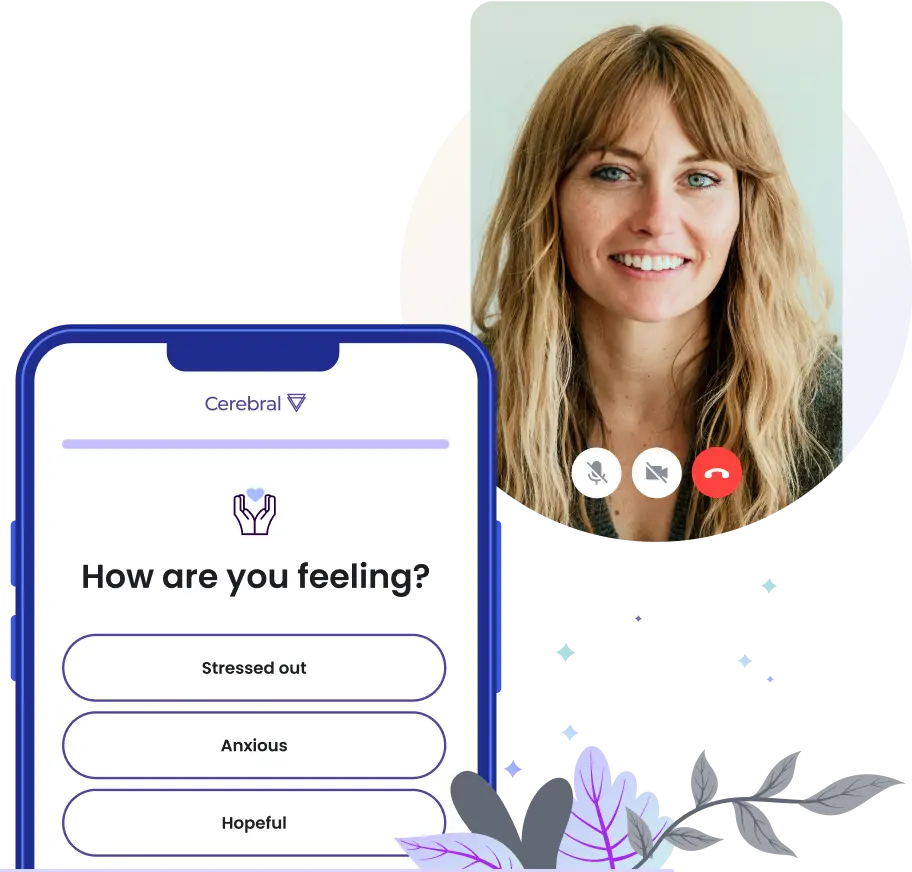/
Depression - PTSD - Substance Use Disorder/
Addressing Suicidal Thoughts: A Guide for Suicide Prevention
Even in the face of its seriousness, suicidal ideation often goes undiscussed because of the stigma that can surround it. But, as we're talking more and more openly about mental health, it's essential that we approach the subject of suicidal thoughts with as much empathy, openness, and support as possible.
If you find yourself grappling with these thoughts, or if you're trying to understand and support someone you care about who is, this guide is for you.
Suicide prevention support
If you're thinking about acting on suicidal thoughts, reach out for help immediately.
- Call 911 if you’re having a mental health emergency.
- Text HOME to 741-741 if you're emotionally distressed and need immediate support.
- Call or text 988 Suicide & Crisis Lifeline. Chat service is available at 988lifeline.org.
What is suicidal ideation?
Suicidal ideation transcends mere fleeting thoughts about death; it's a whole range of thinking that might start with not wanting to wake up and can go all the way to planning how to end one's life. Often accompanied by a sense of hopelessness, these intrusive thoughts can be potentially dangerous.
Despite the severity, feeling this way doesn't have to be permanent. Instead, these thoughts can be a signal that indicates deeper psychological distress and emotional pain that need to be addressed.
The prevalence of intrusive thoughts
While it can feel isolating to experience, this mental health condition affects many. Every year, millions of people report these thoughts to medical professionals. Between 2015 and 2019, the CDC found that an estimated annual average of 10.6 million U.S. adults had thoughts of suicide in the past year, which accounted for about 4.3% of the adult population.
Intrusive thoughts don't discriminate — depression can affect individuals of any age, gender, education level, socioeconomic status, or background. Suicidal ideation is part of a broader mental health landscape; it’s not a ‘character flaw.’
What causes suicidal thoughts?
The causes of suicidal ideation are as varied as the individuals who experience it. They often stem from life circumstances, mental health disorders, or personal resilience levels. Common underlying conditions can include:
- Major depressive disorder
- Bipolar disorder
- Posttraumatic stress disorder (PTSD)
- Social isolation
- Chronic pain
- Substance use disorder
Understanding the warning signs of suicidal ideation in others
For friends and family, recognizing the warning signs for suicide is paramount for timely intervention. The signals can look similar to the signs of depression and anxiety, but are typically more severe. Look for these behaviors:
- Withdrawal from social circles
- Giving away possessions
- Sudden calmness after a period of depression
- Statements of feeling hopeless or having no purpose
Remember: Not everyone exhibits clear ‘red flags,’ and a person at risk might go to great lengths to hide their pain.
How is suicidal ideation diagnosed?
Identifying suicidal ideation typically occurs during a supportive conversation with a mental health expert. These caring professionals will talk with a patient, sometimes using questionnaires, to better understand their feelings and the severity of the thoughts they're facing.
They will also look for any underlying mental health conditions or life experiences that may be contributing to or exacerbating the intrusive thoughts.
The recognition of suicidal ideation is less about certainty and more about concern. The presence of suicidal ideation often prompts an immediate need for intervention, regardless of other diagnoses.
It's about recognizing that these feelings are a call for help and responding with the urgent care and support needed.
What to do if you are experiencing suicidal ideation
When you’re experiencing suicidal ideation, seeking help and taking action are crucial.
Getting urgent help
Seek help immediately if you're thinking about acting on suicidal thoughts. The 988 Lifeline provides 24/7, free, confidential support and crisis resources. Your options also include calling 911 or going to the nearest emergency room.
No matter what course of urgent help is seen as the best fit at the moment, you will want to seek the support of a mental health professional as soon as possible. That also can be your first step when experiencing distress.
Steps to take when it isn’t an emergency
If you’re not in immediate danger, these are the first steps you could take toward getting the judgment-free help you deserve.
1. Make an appointment with a mental health professional
Professional intervention is crucial in managing the risk of suicide or self harm. A mental health professional will provide a safe space to explore the thoughts and feelings you are experiencing. They can guide you to understanding the factors and strategies to manage your mental well-being effectively.
2. Identify and remove triggers
Start by identifying the triggers that lead to these intrusive thoughts. They might be certain places, people, or events that consistently lead to distress. It might not necessarily mean avoiding them permanently, but it can allow for a safer environment while you address this mental health condition.
3. Reach out to a close friend or loved one
You’ll need a strong support system. You may be nervous about opening up, but doing so with a trusted, supportive connection can be a critical step in alleviating the burden, finding relief, and embarking on recovery.
4. Call a suicide hotline
If you don’t feel comfortable talking to someone close to you at the time, a suicide hotline can be an invaluable mental health resource. Specialists on these hotlines are trained to support and assist those in crisis.
Managing suicidal ideation is a process; there will be ups and downs. The most crucial thing is to keep moving forward and continue seeking help from mental health resources.
Treatment options for suicidal ideation
There is no one-size-fits-all approach to treating suicidal ideation. Treatment will vary based on the individual’s needs but may include psychotherapy, medication, or a combination of the two. Hospitalization or intensive outpatient programs may be necessary for those at immediate risk of self-harm.
Additionally, new approaches to reducing suicidal ideation are continually being explored and implemented, often creating expanded access to care.
Treatment goals
Regardless of the course of treatment, the focus will be on achieving several key goals.
- Address the underlying factors contributing to the intrusive thoughts.
- Build coping strategies for preventing suicide.
- Create a support network for the individual.
Individuals will be actively involved in their treatment plan, working collaboratively with their care team.
The path to recovery
Recovery from suicidal thoughts comes with its own challenges, but many individuals who have once experienced these thoughts have gone on to live fulfilling lives. Recovery often involves finding the right treatment, building a solid support system, and learning healthy coping mechanisms.
We know that each person's road to recovery is unique, but it’s important to avoid projecting set timelines or expectations.
Celebrating the small victories can make a world of difference. Whether it’s practicing a new coping skill or continuing to seek help, these concrete steps signify resilience and strength.
Remember: Patience and consistency in support are key if you’re standing by someone in recovery.
The myth and reality of suicidal thoughts and creativity
There is a common misconception that suicidal ideation is a byproduct of creativity. While individuals with artistic inclinations might be predisposed to deeper emotional experiences, it’s crucial not to romanticize or normalize the suffering that comes with suicidal thoughts.
The art lies in expressing your emotions in a healthy manner that supports your well-being rather than harming it.
Art, writing, and other creative outlets can be a powerful force in recovery. However, these outlets should be harnessed under the guidance of a mental health professional so their benefits can enhance structured therapy and/or medication like anti-depressants or mood stabilizers.
The role of community in suicide prevention
Support can take many forms, from suicide prevention organizations and support groups to simply being there for someone in need. By building a community that is educated on the warning signs of suicide and the steps to take to support someone in crisis, we can provide a safety net for those who are in need.
Engaging in open, honest conversations about mental health and suicide removes the stigma that often surrounds these topics. Creating a safe space to talk makes it easier for people to seek help and for those around them to provide support.
If you or someone you know is struggling with suicidal thoughts, please know that there is hope and help available. Reach out to a mental health professional, call the national suicide prevention hotline at 988, or talk to someone you trust.
Remind yourself: You are not alone — there are people who care and want to help.
Working to stop suicidal thoughts
Cerebral is continuing to make strides in improving clinical quality and safety for those experiencing suicidal ideation. With systems in place to connect you to care quickly in crisis situations, not only can unnecessary emergency room visits and hospitalizations be avoided, but meaningful improvements in symptoms can be made in a short period.
Of the patients who come to Cerebral considering suicide, half of the individuals stopped having thoughts of suicide within an average of 6 months of treatment. This highlights the powerful impact of seeking support and the real possibility of regaining a sense of hope and purpose.
Critical resources
- 988 Suicide & Crisis Lifeline offers free and confidential support via phone, text, or chat.
- Crisis Text Line allows one to text with a trained crisis counselor for free by texting TALK to 741-741.
- Veterans Crisis Line enables veterans to get help via text by sending one to 838255.
- Vets4Warriors provides free, 24/7 peer support for veterans via phone at 855-838-8255 or by email.
- The Trevor Project offers immediate crisis support for LGBTQ+ youth via phone at 1-866-488-7386 or by texting START to 678-678.
Image by rawpixel.com on Freepik

Differences in PTSD by Gender Identity

The Benefits of Walking to Help Depression

Retirement and Depression: Why It Happens and How to Cope

Call 911 if you’re having a
mental health emergency
Text Home to 741-741 if you're in emotional
distress and need immediate support
Call or text 988 Suicide &
Crisis Lifeline. Chat service
is available at 988lifeline.org.